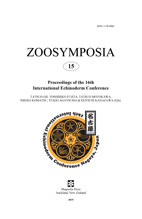Abstract
Bolboporites is an enigmatic Ordovician cone-shaped fossil, the precise nature and systematic affinities of which have been controversial over almost two centuries. For the first time, a wide range of techniques (CT-scan, SEM, cathodoluminescence, XPL, UV epifluorescence, EBSD, FT-IR and XRF spectrometry) were applied to well-preserved specimens of Bolboporites from Norway and Russia. Our main finding confirms its echinoderm affinities, as shown by its stereomic microstructure and by the first definitive evidence of its monocrystalline nature. Each cone consists in a single, microporous calcitic crystal with a narrow longitudinal internal canal. These results are combined with all previous data on Bolboporites to critically discuss five alternative interpretations of this fossil, namely theca, basal cone, spine, columnal, and holdfast, respectively. The most parsimonious scenario considers Bolboporites as an isolated spine, which was articulated in life by a short biserial appendage to the body wall of an unknown echinoderm, possibly of echinozoan affinities.

